6 eggplant growing mistakes to avoid for tastier aubergine harvests
Experts reveal the top eggplant growing mistakes to avoid if you want to take your aubergine adventures to the next level
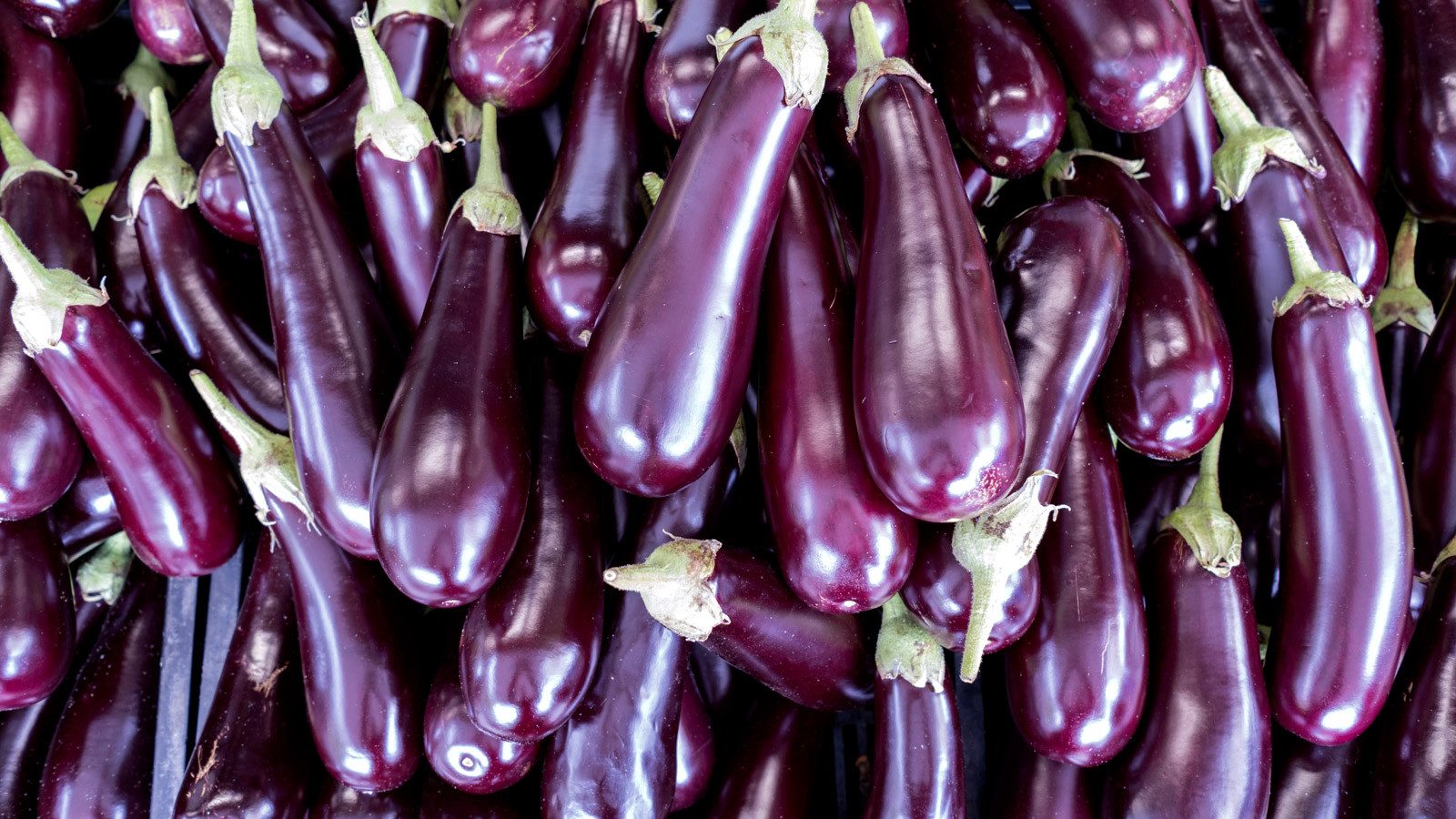

Be you veg-growing newbie or intrepid explorer of kitchen garden exotics, a fear of eggplant growing mistakes is not to be taken lightly. Big on substance and style, the eggplant (Solanum melongena) is a satisfying gourmet meat alternative for vegetarians and food lovers. But while it’s easy to conjure up delectable images of moussaka, baba ganoush, parmigiana and ratatouille, the aubergine’s semi-tropical credentials can be intimidating. And it can be a bit fussy, so mistakes are easier to make than they might be with other veggies.
If you don’t plan ahead, maintain a proactive cultivation routine or allow enough time for the season, the reality of growing eggplants may fail to live up to the fantasy. Figuring out how to grow aubergines can feel like trial and error. And unless you appreciate their unique requirements, your culinary adventures may wind up with bitter, tiny fruits – or no harvests at all. No wonder they often get benched for their less-demanding pepper and tomato cousins. But worry not, as we flag up the major pitfalls to bear in mind – and reveal how you can grow the best eggplants ever.
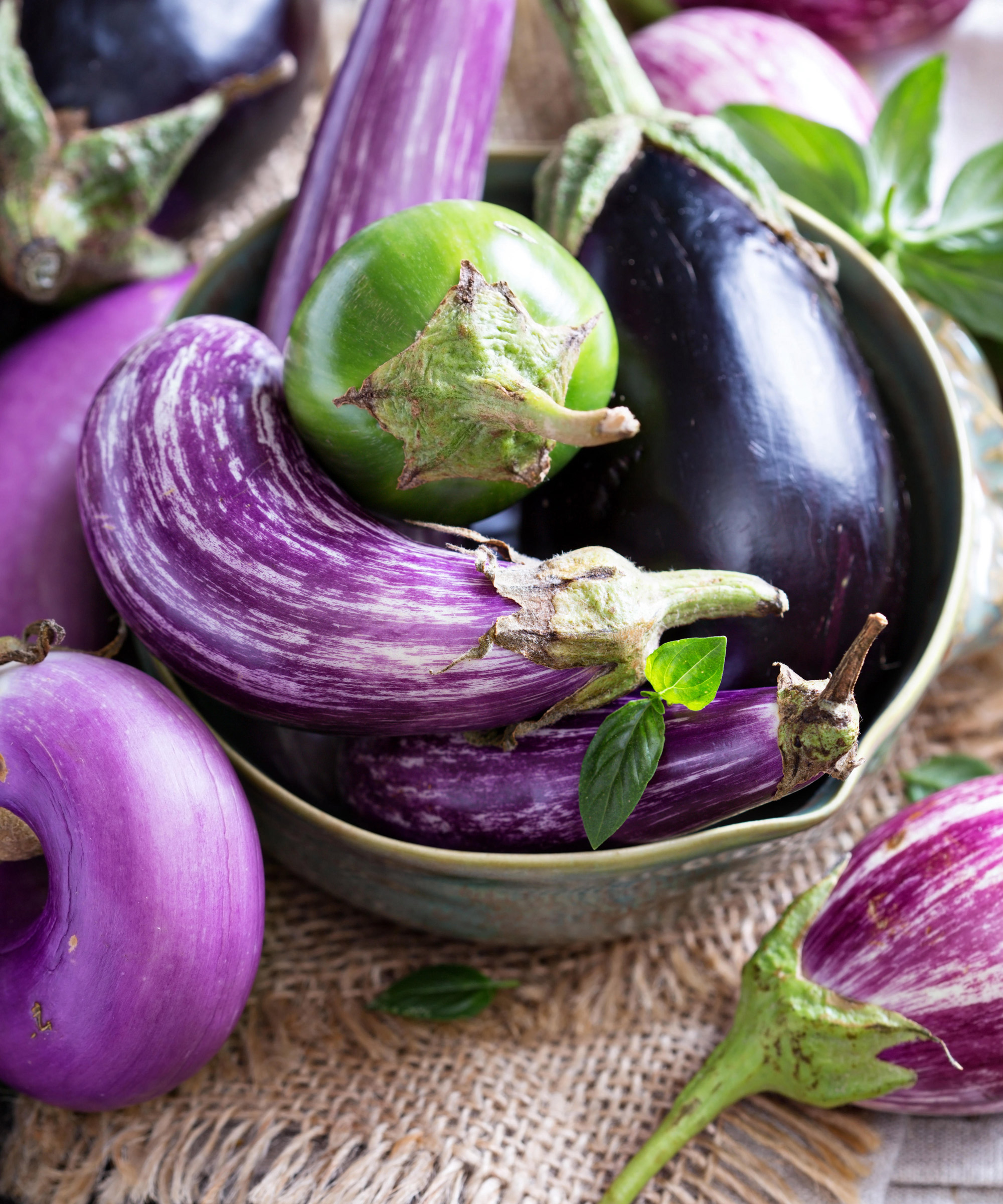
Eggplant varieties may vary widely, but there are some golden rules that enhance them all
6 eggplant growing mistakes to avoid for plump and tender crops
Eggplants may not win any prizes for being the easiest vegetables to grow, and they won’t be appearing in anyone’s top 10 of best plants for beginners, but they are not impossible to master. You just have to respect that they have particular needs. Don’t fall into the trap of thinking you can take shortcuts if you want to grow healthy, well-proportioned eggplants that taste delicious and tender. Take heed of the main mistakes to catch out unsuspecting growers – and get ready for succulent success!
1. Planting eggplants at the wrong time or in the wrong place
These crops are notorious for taking time to bulk up, so it’s important to start them off as soon as you can. That said, there’s no point trying to start them off in chilly conditions. Given that aubergines are long-season crops, this is one of the most common eggplant growing mistakes you can make. ‘Eggplants are tender plants, so they don't handle the elements well,’ says West Coast Seeds’ expert gardener Ve-Jane Duong. ‘Best to plant in a protected spot or cover with a low polytunnel.’ Starting off in a protective environment undercover in February or March means you protect plants from frost while also ensuring they make the most of the growing season and develop the healthiest root systems and fruit sets.
Homes & Gardens veg expert Lucy Chamberlain recommends a heated propagator for germination. Start off in modules or small pots and commit to repotting as plants develop, hardening off before moving outside. Avoid the temptation to grow too many seedlings in close proximity. Cramped conditions also lead to stunted growth and encourage diseases and fungal rots. If you are worried about growing eggplants in small garden spaces, there are several varieties bred specifically for compact growth, such as ‘Rosa Bianca’, ‘Patio Baby’ and ‘Little Fingers’ from Walmart. And don’t forget to give plants access to at least six-eight hours of sunlight per day.
As well as knowing when to plant vegetables, make sure the planting site is well prepped. Gardeners can panic because of the long growing season required, so rush to plant out while the ground is still cold. This is one of the quickest ways to shock eggplants, halt growth and call time. Eggplants hate chills, and this applies as much to the soil or compost as to weather. Keep plants under glass until the risk of frost has passed. Make sure soil is well draining to avoid rots, as well as rich and loamy (conditioning with aged compost is recommended). Eggplants are happiest in soil with a pH of 6-6.5. If you aren’t sure of soil types, check before planting out.
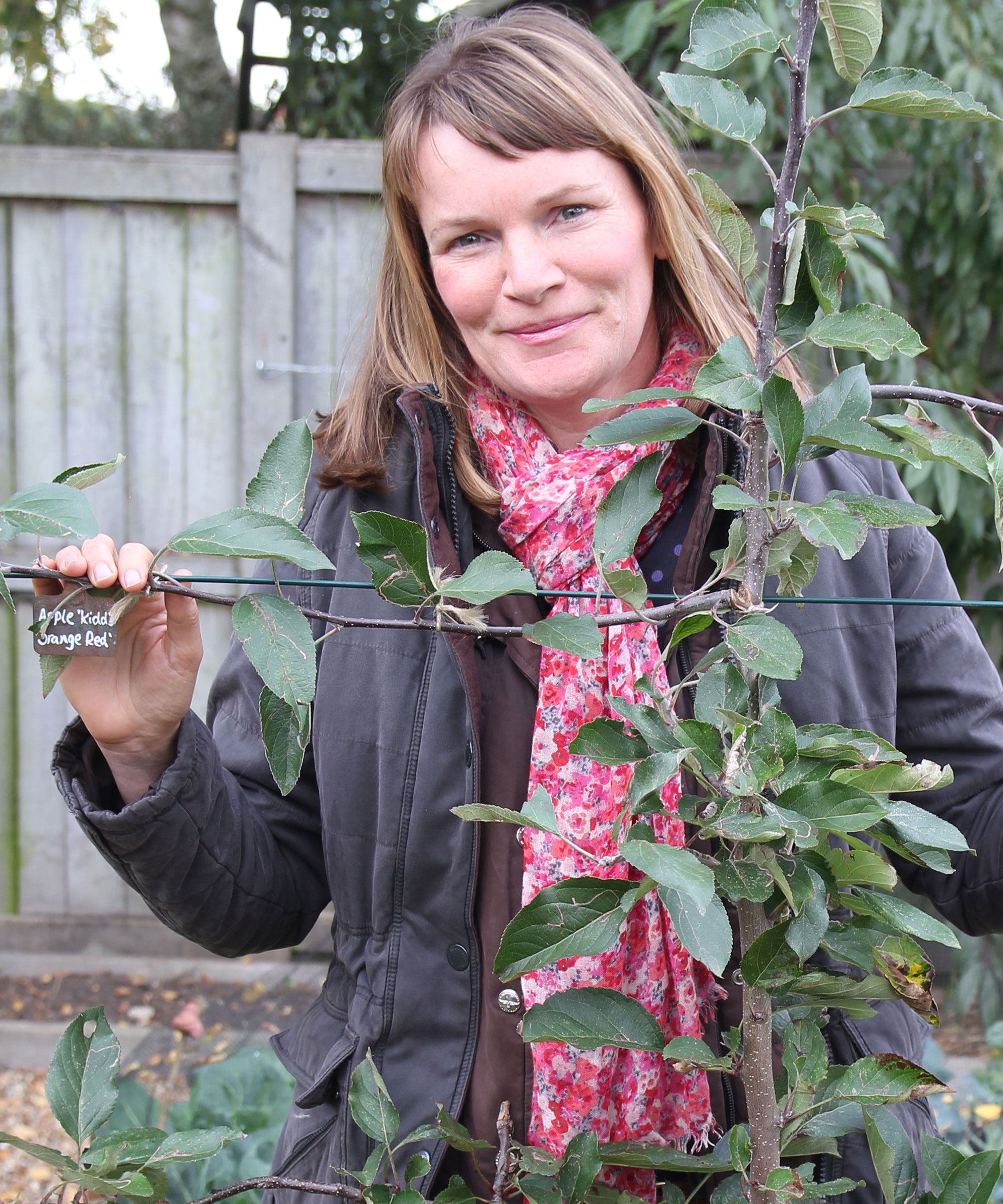
Lucy was a Horticultural Advisor at RHS Wisley and writes regularly for The Garden, Gardeners’ World, The Guardian and Amateur Gardening. She’s also the author of RHS Step by Step Veg Patch, which covers 50 types of fruit and veg. She loves to grow eggplants underglass and loves to experiment with different breeds, elongated fruits and unusual colors.
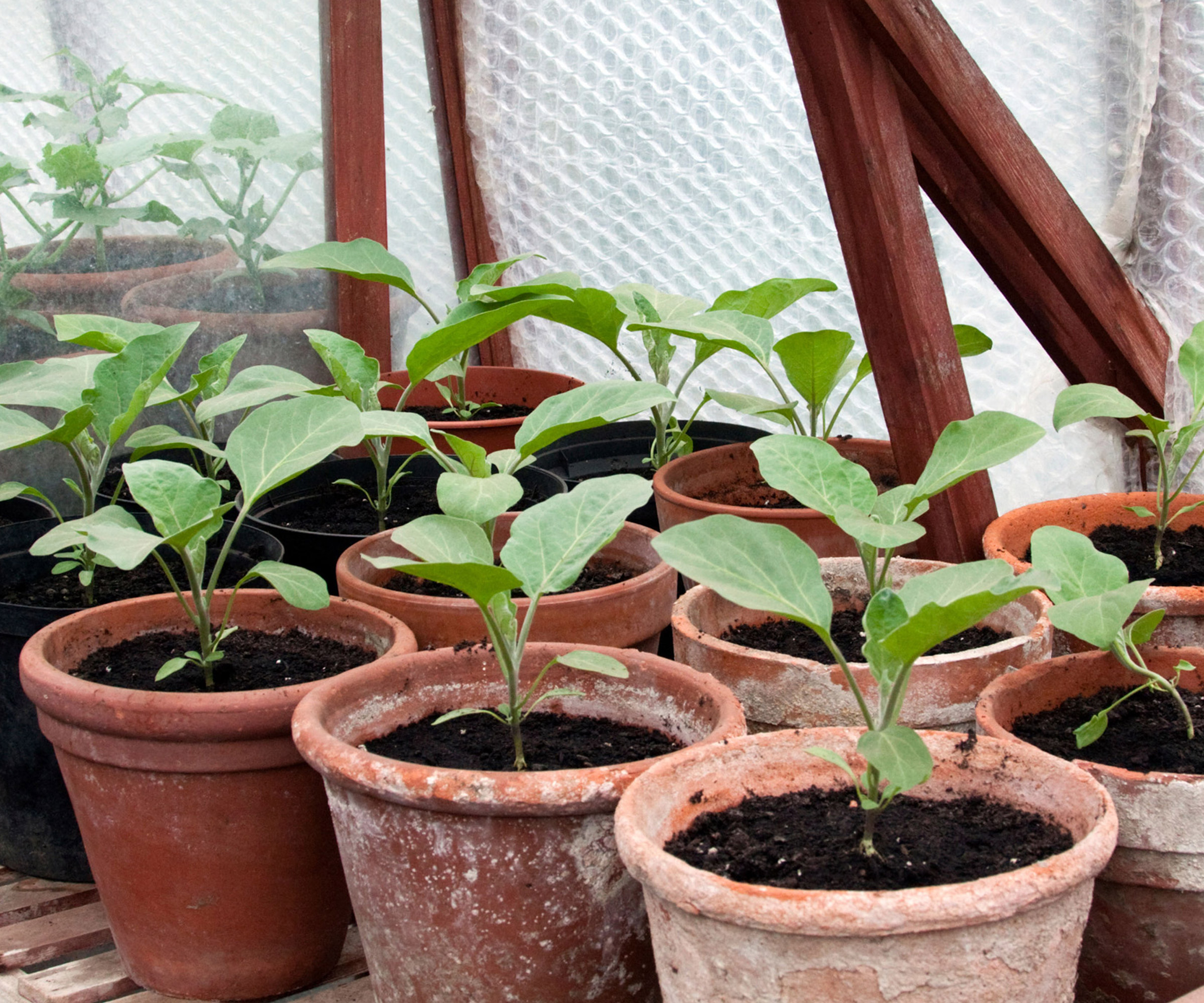
Eggplants can be started under glass but many breeds need potting on before planting out
2. Misjudging eggplant growing temperatures
Trying to cultivate these crops in the wrong temperatures is one of the most common eggplant growing mistakes. Budding enthusiasts either underestimate the importance of warmth, or allow their plants to wither in parched conditions. This is a common problem when you are planning a greenhouse crop. ‘Eggplants benefit greatly from supplemental heat during germination,’ says West Coast Seeds’ expert gardener Britney Price. ‘They are a very tender plant and will have slow growth if not kept warm.’ Keep temperatures at 60-70°F when starting them off. Thereafter, these exotics rely on a steady source of warmth and sunshine (68°F is ideal), and plenty of it. These sun-worshippers do best in USDA zones 4-11.
One thing that catches people out is thinking that these heat-lovers are ok in arid, dry soils. Yes, the soil or compost has to be warm, but make sure plants have a moist, well-drained base. That’s the thing when growing eggplants: you must keep their heads in sunshine, but their feet don’t like to be dry! Make time for mulching at the time of planting to help retain moisture levels. As well as suppressing weeds this is a good way to keep soil temperatures steady. A black plastic mulch can also warm up the earth pre-planting. Use cloches and cold frames if you’re worried about temperature dips outdoors, ensuring you are growing eggplants right.
While dips below 60°F can halt eggplant growth and cause flower drop, you also need to avoid heading off to the other extreme and trying to grow these tenders in extremely hot conditions (above 90°F). This can stress the plant out, and in some cases cause it to shut down completely. One way to safeguard against ‘heat stroke’ is to grow heat-tolerant eggplant varieties such as ‘Rhapsody’, ‘Aswad’, ‘Orient Express’, ‘Thai Long Green’ and ‘Millionaire’ from Burpee. Homes & Gardens expert Anne Swithinbank points out that where eggplants are being grown under glass, you must also keep a close eye on air flow. ‘Ideally, a greenhouse should have side ‘louvre’ vents as well as roof vents to draw cool air through,’ says Anne. ‘Also, space plants well so air can better circulate,’ she adds.

Trained at Kew Gardens and employed in parks department nurseries, Anne has been a freelance horticulturist since 1986. Anne writes for Amateur Gardening and has been a regular panelist on BBC Radio 4’s Gardeners’ Question Time for 27 years. She likes to grow eggplants under glass in March to ensure the best harvests.
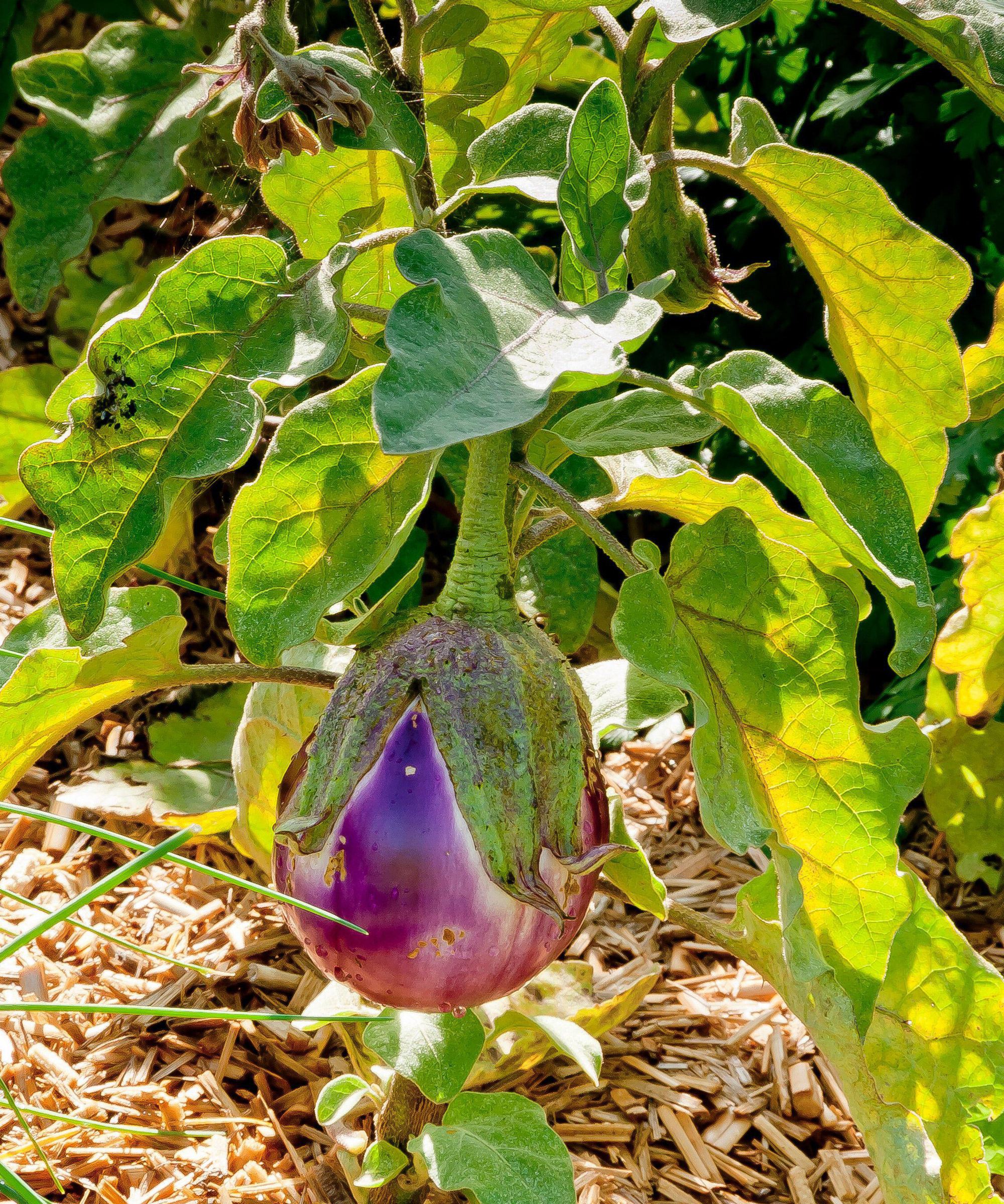
A good mulching can help regulate temperatures in the ground as eggplants like ‘Violetta Di Firenze’ strengthen their root networks
3. Not watering or feeding eggplants properly
When growing eggplants, most ‘make or break’ activity is needed in the six weeks after planting. One of the most critical jobs is watering. According to experts, eggplant fruits are 90% water. Given that astonishing fact, one of the biggest vegetable gardening mistakes is to underestimate the moisture levels needed to maintain healthy root and foliage development and sustain the fruits as they ripen. Misjudge this, and you’ll wind up with bitter or tasteless berries. The eggplant is a hungry baby, and any dip in attention will cost you dear. Dehydration leads to stress, which causes flowers to drop and fruit production to fail.
As a rough guide for when to water plants, apply an inch of deep hydration per week. Increase this in hot, dry spells, and once plants start fruiting. It’s best to water deeply once a week but to do it properly, rather than sprinkling insufficiently every other day. Using drip irrigation or a soaker hose can help target the roots deep underground. Again, humidity is vital, so mist flowers with tepid water twice daily to help fruit set. Another mistake is to keep watering for too long. You need to stop later in fruit growth, as Lucy explains. ‘Begin reducing the amount of water in August,’ says Lucy. ‘This gentle stress will help ripen up the last fruits.’
You need to apply a slightly different metric for fertilizing eggplants. It doesn’t matter if you use the best fertilizers if you apply them too late in the game. Starting to feed too late is a classic mistake for many growers. Begin early for the biggest yields and best eggplants. Apply a diluted general-purpose feed at the time of planting, and at two-weekly intervals thereafter. Then, once you see fruits, you need to switch to a high-potash liquid plant food, says Anne. ‘Use every fortnight from when they flower and begin to set fruit. You can make your own feed by adding a little water to half a bucket of comfrey leaves, weighed down with a brick, and dilute until pale brown.’
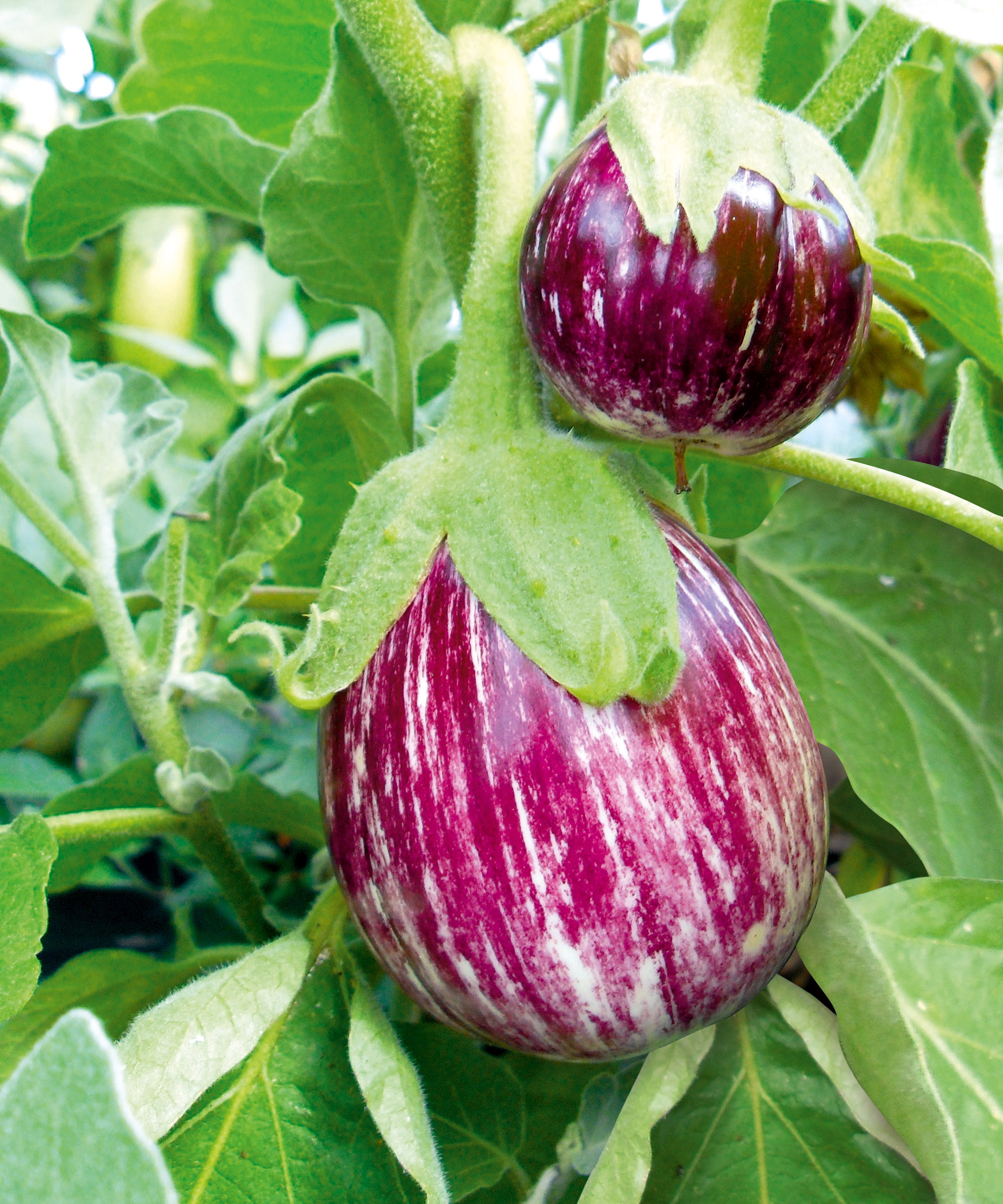
It’s important to give eggplants a high potash feed as fruits form
4. Forgetting to give eggplants support
One of the biggest eggplant growing mistakes is also one of the easiest to prevent. Sometimes, gardeners get so worried about the nitty-gritty of timings and temperature controls, they forget one of the most obvious aspects of eggplant growing: adequate support. Trusting these top-heavy crops to gravity’s pull is a recipe for disaster, as burgeoning fruits can overload, topple and snap plants. Anyone who grows tomatoes appreciates the importance of knowing how to stake a tomato plant, and the same principle applies with eggplants. So, depending on the variety, climbing plant support will be a life-saver – especially with taller breeds like ‘Black Beauty’, ‘Galine’, ‘Dusky’, ‘Bonica’, ‘Epic’ and ‘Ichiban’ from Walmart.
Whether you grow eggplants in borders, large containers or raised beds, plants need support prior to fruiting. Do this using a framework of poles, a cage, a vegetable garden trellis, a sturdy wooden stake, bamboo canes, or similar. Lucy suggests adding support as soon as you can to mitigate soil disturbance. Make sure the stakes are sunk an inch or two from the plant’s base. Keep an eye on the main stem and fasten in place at regular intervals as it gets taller. When plants are a foot tall, pinching out tips can also help with the structure of the plant, promoting a bushier, more stable plant, as well as helping to produce fruit. Giving eggplants the relevant vertical garden supports will also combat extremes of weather.
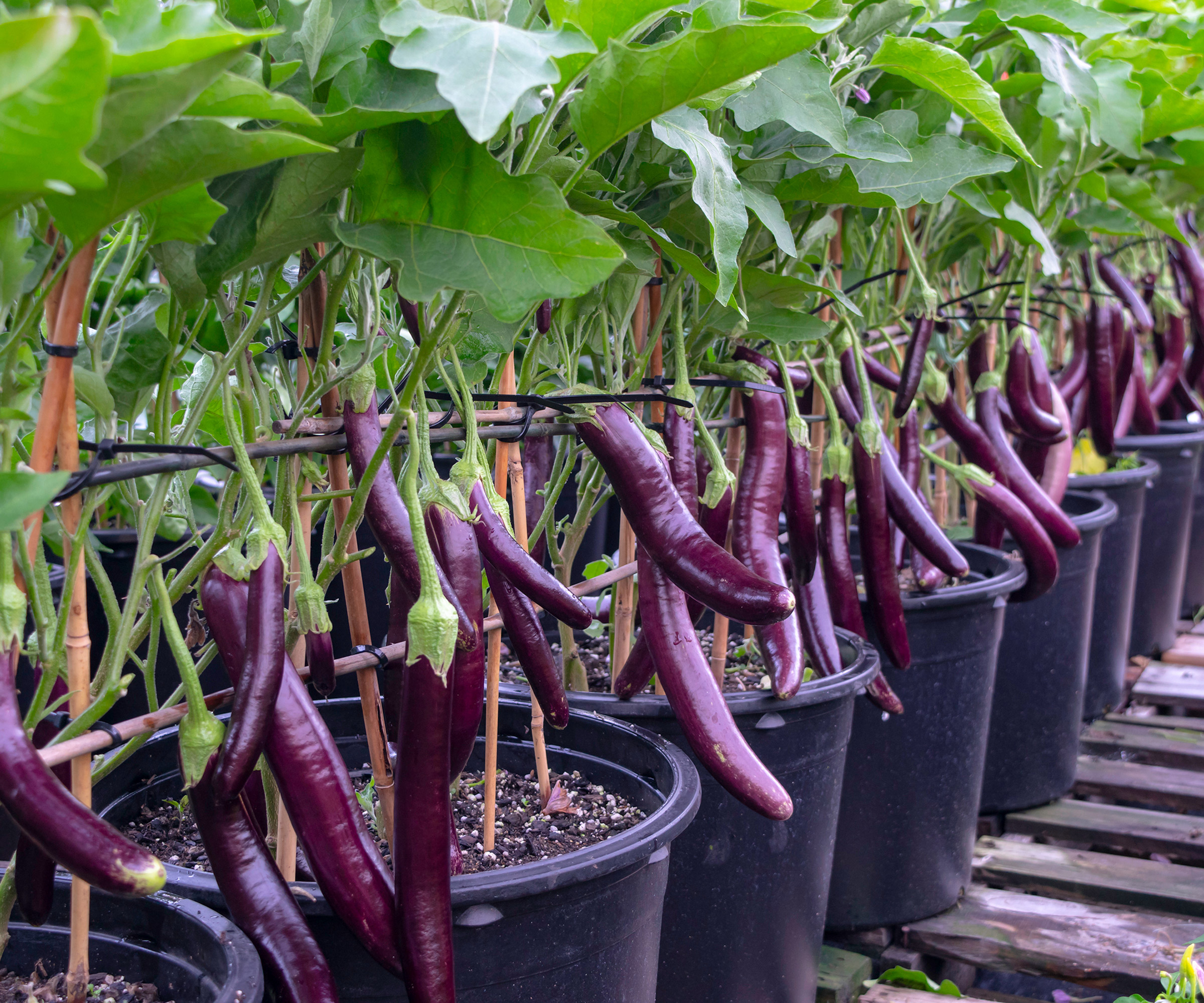
Varieties like ‘Early Long Purple’ benefit from being supported using frames or stakes
5. Ignoring eggplant pests and diseases
Even after planting correctly in the right place at the right time, the best eggplants can fall foul of pests and diseases. This is especially true for anyone who is growing eggplants underglass. Don’t kid yourself that the problem will fix itself. As Lucy points out, glasshouse pest populations can exponentially explode. Some of the most common eggplant pests quickly become unmanageable when ignored, stunting growth and preventing fruit set. Activity ramps up in high summer, so avoid complacency. Check plants daily and, at the first signs of trouble, act swiftly.
Mottling or webbing on foliage is a sign of red spider mites, which thrive in dry, hot conditions. Misting regularly can prevent this problem. You can get rid of spider mites if you act fast with organic sprays or diluted soap. If you see greenfly on shoot tips or the undersides of leaves, or a sticky honeydew or sooty markings, you have aphids. You can get rid of aphids with organic sprays, homemade bug sprays like diluted neem oil, or aphid predators like ladybugs or lacewings. Sap-sucking whiteflies can be tackled with regular blasts of water from a hosepipe, using your finger to create a jet, says Lucy. This won’t eradicate the whitefly, but it will reduce numbers, giving you time to implement controls like predatory wasps.
Sudden wilting and yellow patches could also be signs of fusarium wilt, while leaf curl and streaking may warn of mosaic virus. In these cases, prevention is simpler than cure. Plant in raised beds or well-draining soil, rotate crops and remove weeds. Try disease-resistant eggplant varieties such as ‘Black Beauty’ from Etsy to prevent blossom end rot, and ‘Nadia’ or ‘Epic’ for resistance to tobacco mosaic virus. You can prevent botrytis if you remove old flower petals. Good spacing and airflow can also reduce the risk of disease, says West Coast Seeds’ expert gardener Mandy Moon. ‘Make sure to leave about 1ft between plants,’ says Mandy.
Clever companion planting can also save problems later: try sage or kohlrabi to deter flea beetles, or thyme and oregano to keep aphids at bay. Nasturtiums and marigolds are also effective pest controls. Avoid planting near geraniums, which are susceptible to leaf blight.
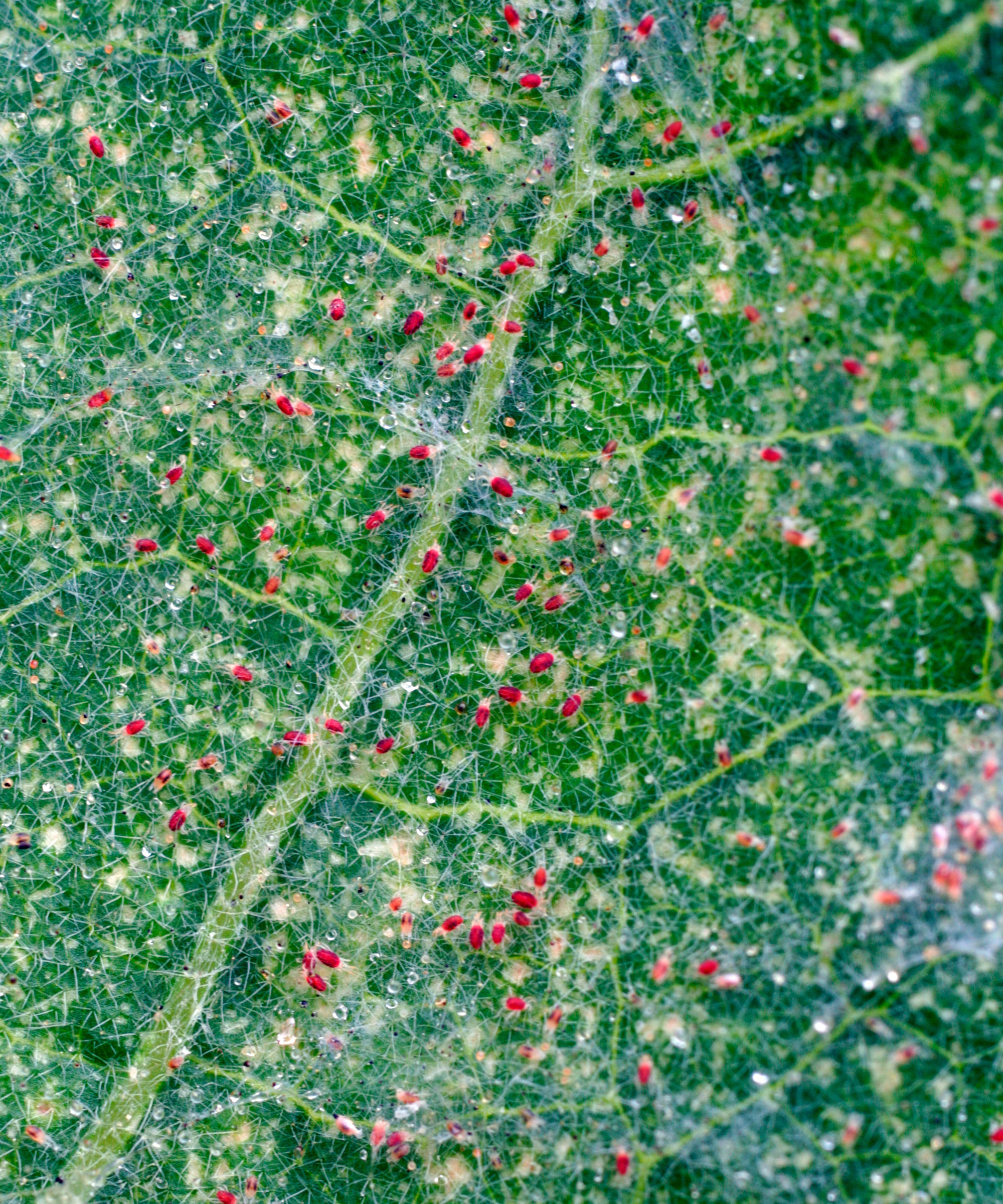
Watch out for leaf discoloration and webbing, signs of a red spider mite infestation
6. Harvesting the wrong way or at the wrong time
You’ve got your head around soil conditioning, temperature balances, plant supports, watering, feeding and pest controls – but there is one more hurdle left to clear, and it’s a biggie. Harvesting these fruits at the wrong time is one of the biggest eggplant growing mistakes you can make. Curiously, catching eggplants in their prime relies on removing them from the stems before they reach ‘full maturity’, which can be a tough call. And we get it, it seems counterintuitive to eat them early – which is why it’s easy to make the mistake of leaving plump, glossy, creamy fruits in situ, waiting for them to get bigger, thinking that must be better. What tends to happen instead is that they lose that shine and over-ripen, at which point they get dull, bitter and spongy, laying waste to months of hard work.
So don’t leave eggplants to wrinkle or lose that lustrous sheen. Depending on variety, you can pick eggplant around 12-15 weeks from planting or transplanting (four or five months from sowing). If you are interested in good early-maturing eggplant varieties, try ‘Patio Baby’, ‘Early Long Purple’, ‘Galine’ or ‘Early Midnight’ from Burpee. One interesting way to check classic rotund breeds is to tap them, says Lucy. A thud indicates firm, tender fruit; a lighter, woody noise may mean they are over-ripe. You can also press a finger into the skin of the fruit – if it takes a second to spring back, it’s ready. If it springs back immediately, it needs a little more time. And if it leaves a deep groove, it’s over-ripe. Cut (don’t pull) fruits with one-inch stalks using a sharp knife or secateurs for the best eggplants.
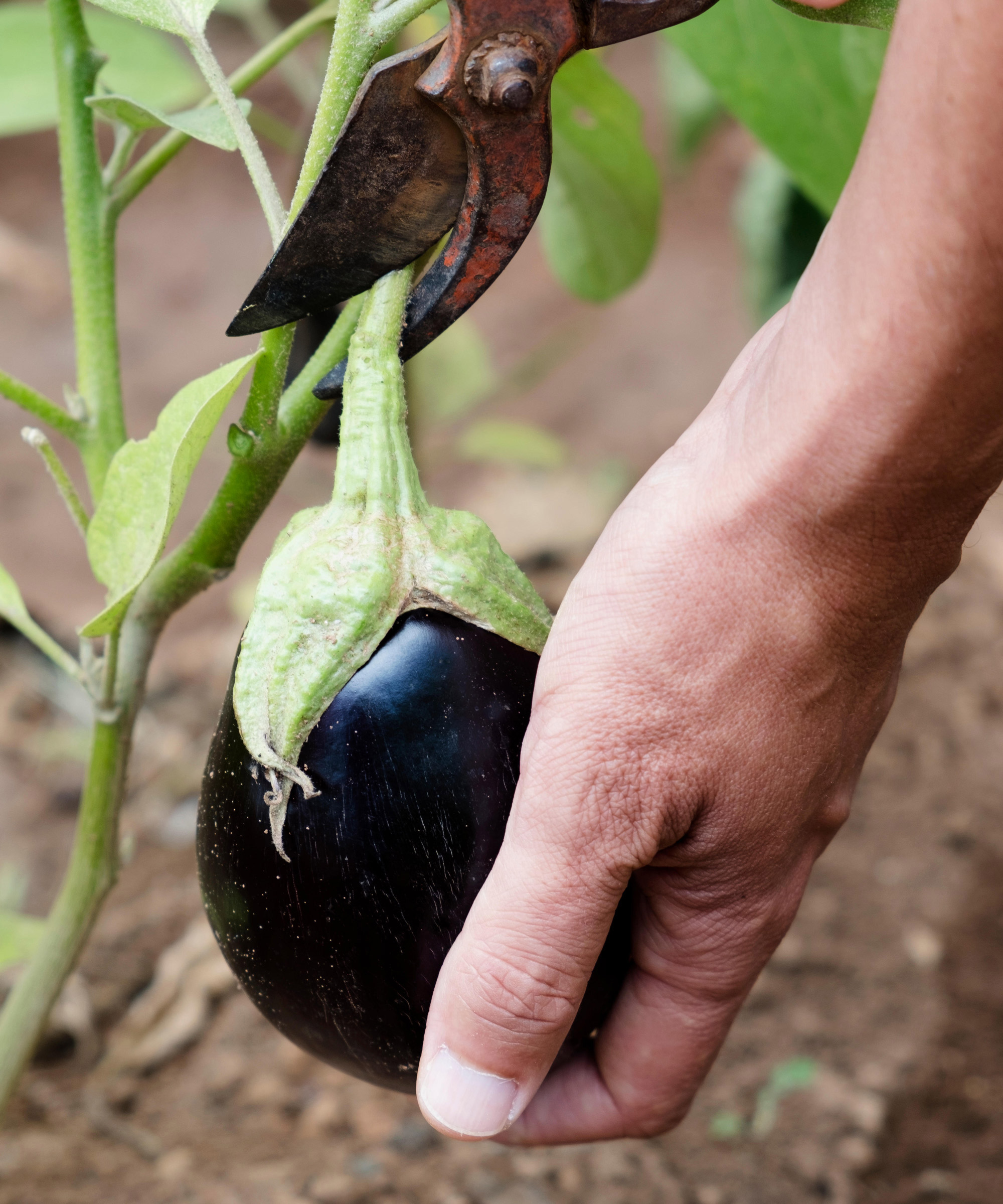
Harvest with a sharp knife or secateurs and don’t be tempted to pull fruits off by hand
FAQs
Why is my eggplant not producing fruits?
If plants don’t grow fruits well (or at all), several eggplant growing mistakes could be to blame: incorrect watering, poor soil health, sowing too soon, or inadequate temperature regulation. If flowers drop prematurely, this could be due to stress on account of dehydration, temperature extremes (above 75°F/below 40°F) or poor feeding. However, if flowers look healthy but don’t turn into fruits, the main culprit is pollination (or lack of). This is an increased risk if you are growing eggplants under glass.
In this case, you can pollinate flowers by hand using a small paintbrush. Anne has an even more adventurous suggestion. ‘The best way to get a better fruit set rate is an electric toothbrush,’ says Anne. ‘Gently touch the back of flowers for a few seconds. The vibrations do an incredible job of dislodging pollen off the male organ onto the female.’
What happens if I leave crops on eggplants too long?
It’s not always easy to confidently remove eggplant fruits from plants. This is partly because of the long growing season, and partly because we are being told that there is a fine line between ‘under-developed’ and ‘overly mature’. You may be tempted to leave fruits in situ longer, thinking those extra few days will give you a bigger crop – this is a risky move. Crops that aren’t harvested while glossy and firm don’t always get bigger with age. What often happens instead is they get tougher, spongier or bitter.
While the best eggplants are harvested while relatively young, there are ways you can enjoy tasty eggplant fruits that are still developing at the end of the growing season (September). A few clever greenhouse ideas can improve your chances with fruits that seem just a little way off perfection. Lucy recommends that you boost temperatures under glass as external temperatures start to cool. Close vents and adjust blinds to raise warmth levels. ‘Putting plants under slight stress speeds up ripening,’ says Lucy.
You should also stop watering, and maybe try adding a bed of straw around the base of plants. If plants are growing in greenhouse beds or growbags, Lucy recommends sliding a garden fork under the rootball and part-lifting the plant, as this can also accelerate the ripening process.
Is it harder to grow eggplants in containers?
Growing eggplants in pots can help you control a few of the environmental issues that might otherwise result in making mistakes. Increased mobility helps you relocate plants (say, between patios and indoor spaces such as greenhouses) where light and warmth might cause problems, or where chills or harsh weather are likely. The trick to successful container gardening with eggplants is to keep compost moist and to ensure taller varieties are supported with stakes. Adequate drainage is vital, as these plants detest soggy roots (terracotta pots and growbags are good for drainage). And don’t forget to add a diluted liquid feed.
Above all, if you want to steer clear of eggplant growing mistakes in pots, keep potting on plants so they don’t get starved of nutrients. Eggplant root systems can quickly outgrow their confines. However, it’s best to increase pot size incrementally, rather than trying to jump a few sizes bigger. Far from buying you time, this can overwhelm a plant. As Anne explains, the secret is to move young plants promptly and by stages to bigger pots. ‘They need to reach a large size by midsummer so they have plenty of energy to flower, set fruit and ripen,’ says Anne.
One final tip for avoiding disappointment when growing large-fruited eggplant varieties: restrict the number of fruits each plant can produce. This lets the plant focus its energy on bulking up a few fruits well, rather than spreading itself too thin and running out of steam before harvesting. This is also one of the most common tomato growing mistakes, and it’s easily avoided. Just remove excess flowers and limit potential numbers to six per plant. As Anne points out, fruit reduction means remaining eggplants have a better chance of reaching full size in the growing season.
Sign up to the Homes & Gardens newsletter
Design expertise in your inbox – from inspiring decorating ideas and beautiful celebrity homes to practical gardening advice and shopping round-ups.

As assistant editor of Amateur Gardening magazine, Janey's gardening passion was fostered from an early age, when her amazing mum had her deadheading hydrangeas, mulching roses, and propagating strawberry plants from runners for school open days. She's also taken part in lots of conservation and rewilding projects for the RHS and TCV as a way of exploring her horticultural horizons.
-
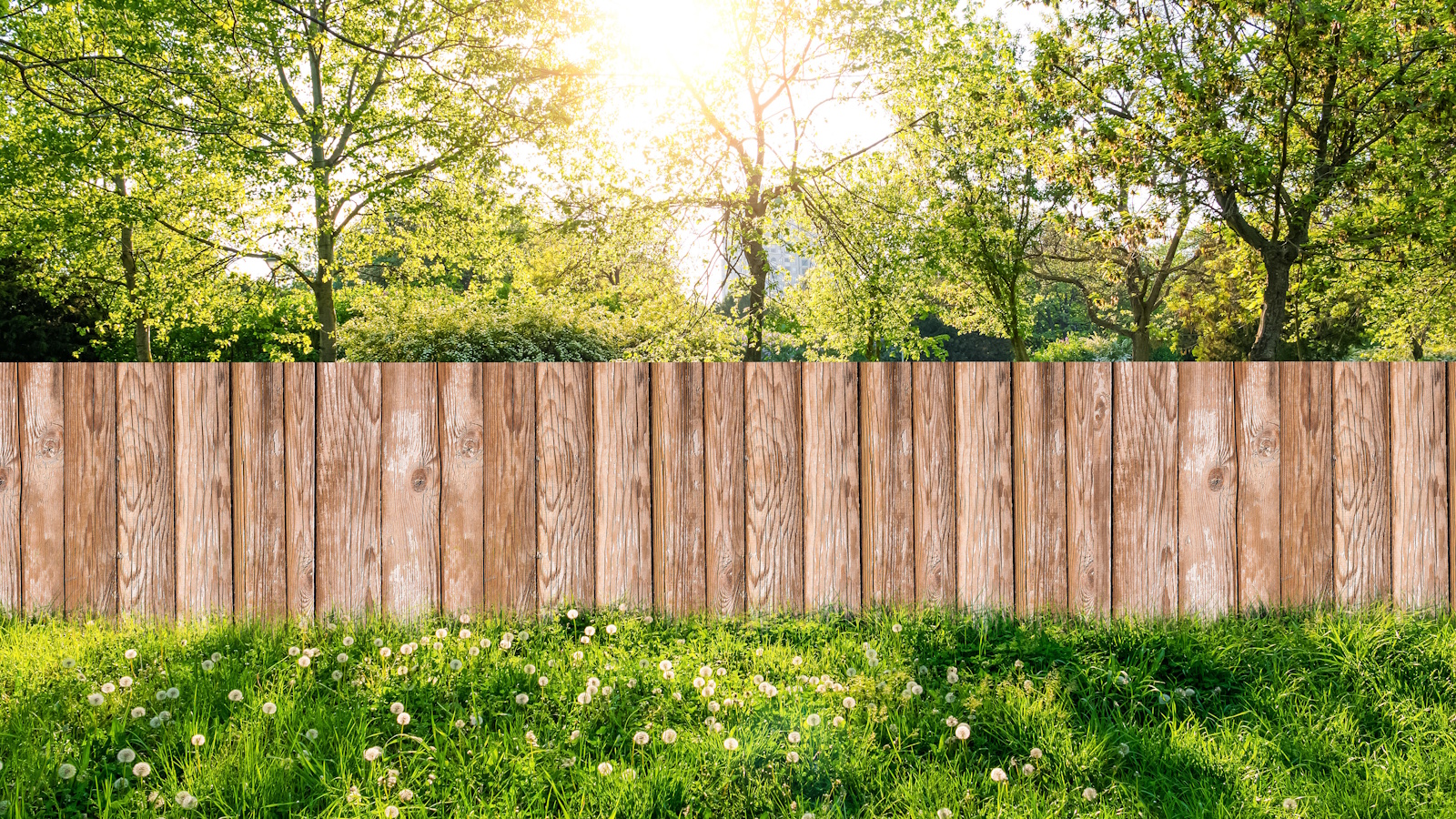 Can my neighbor paint their side of my fence? Here's the legal regulations you need to know to avoid disputes, plus when to take action
Can my neighbor paint their side of my fence? Here's the legal regulations you need to know to avoid disputes, plus when to take actionThere's no simple answer to this question, so it's important to do your research before taking action
By Tenielle Jordison
-
 ‘It leads to more headaches than it's worth’ – 4 reasons you should never store things in your oven, including fire risks and serious illness
‘It leads to more headaches than it's worth’ – 4 reasons you should never store things in your oven, including fire risks and serious illnessYour oven is for cooking, and cooking only, experts urge
By Chiana Dickson